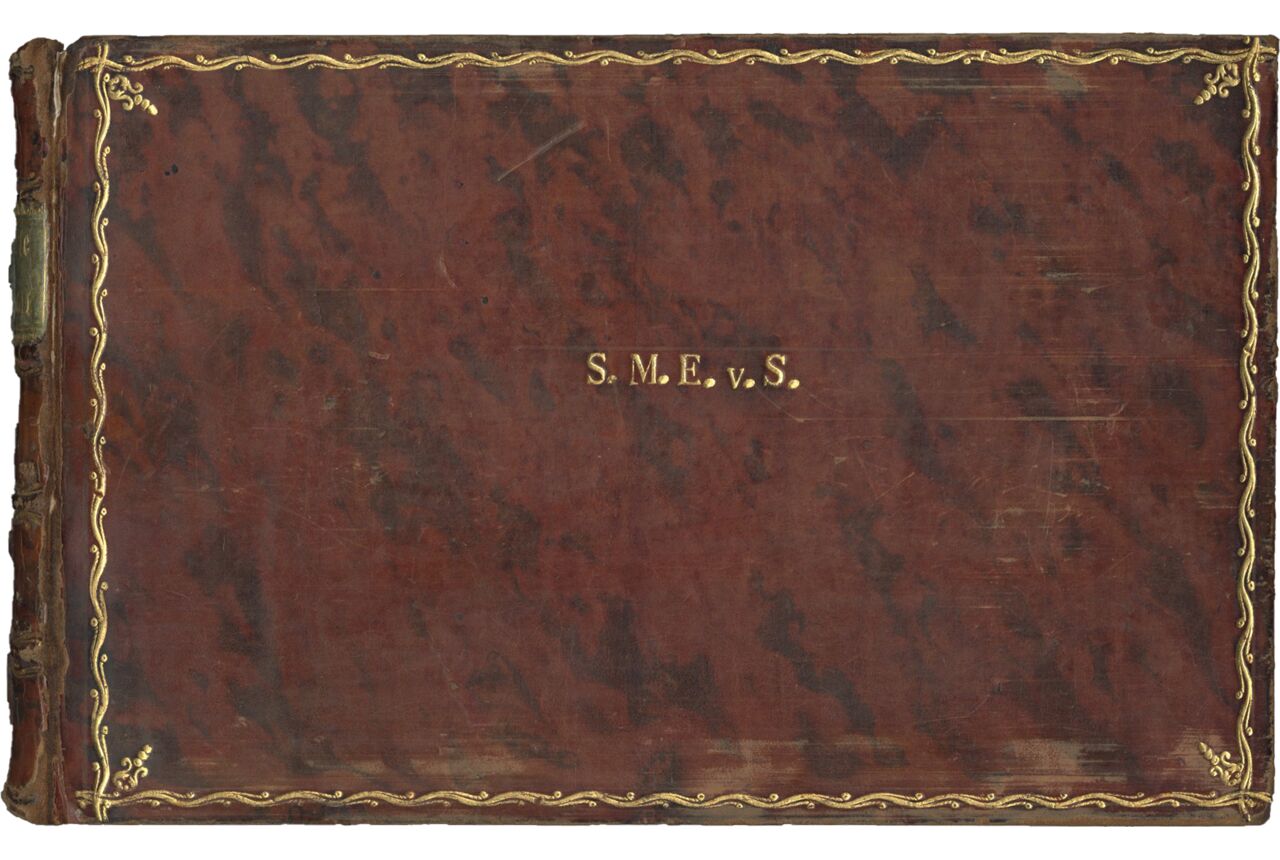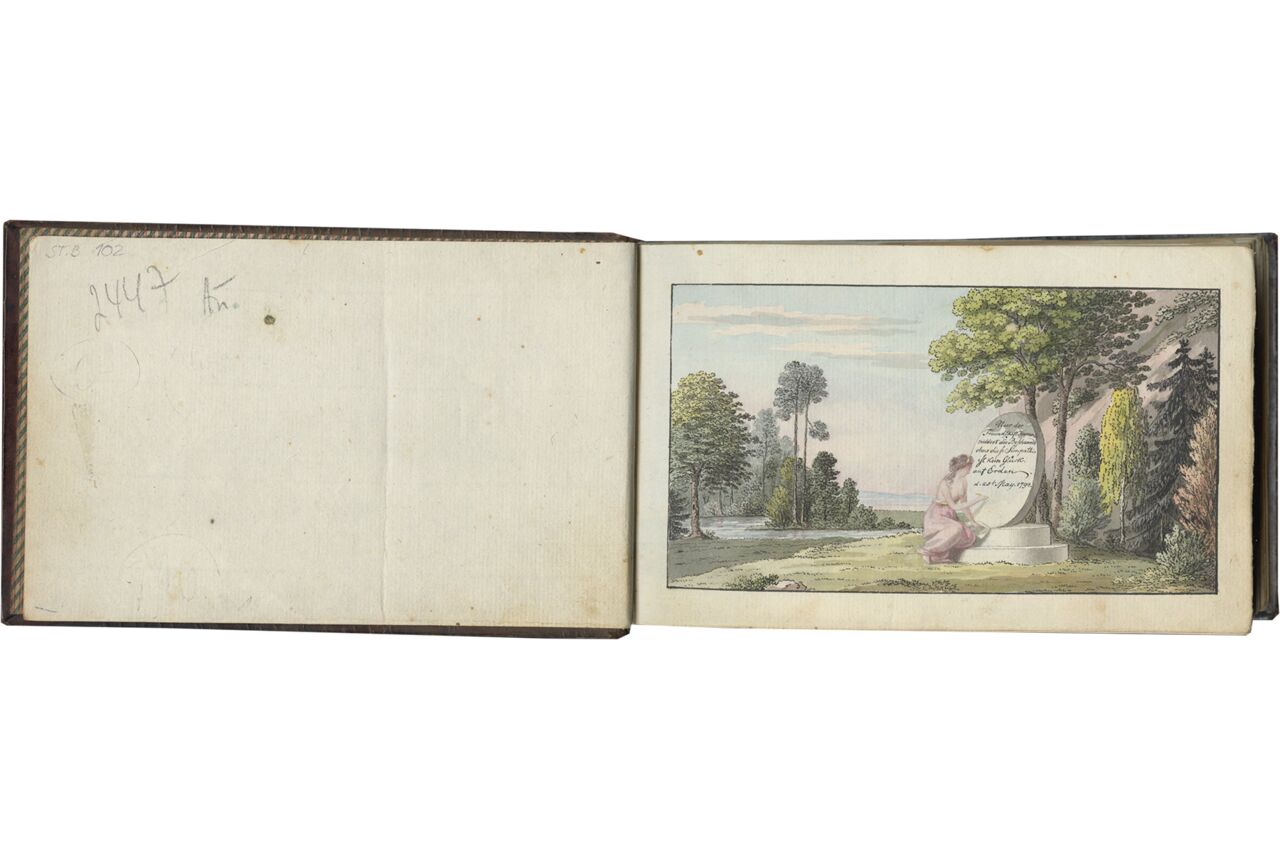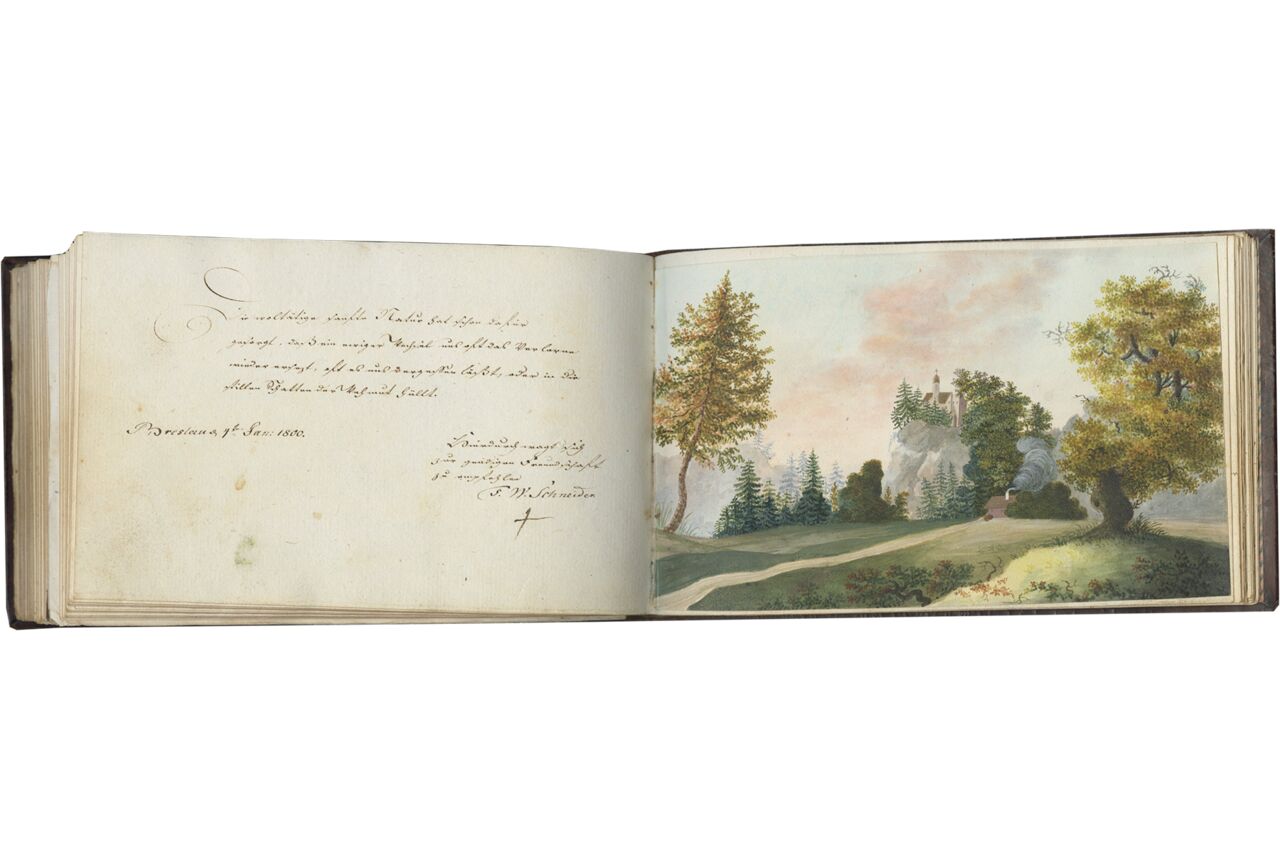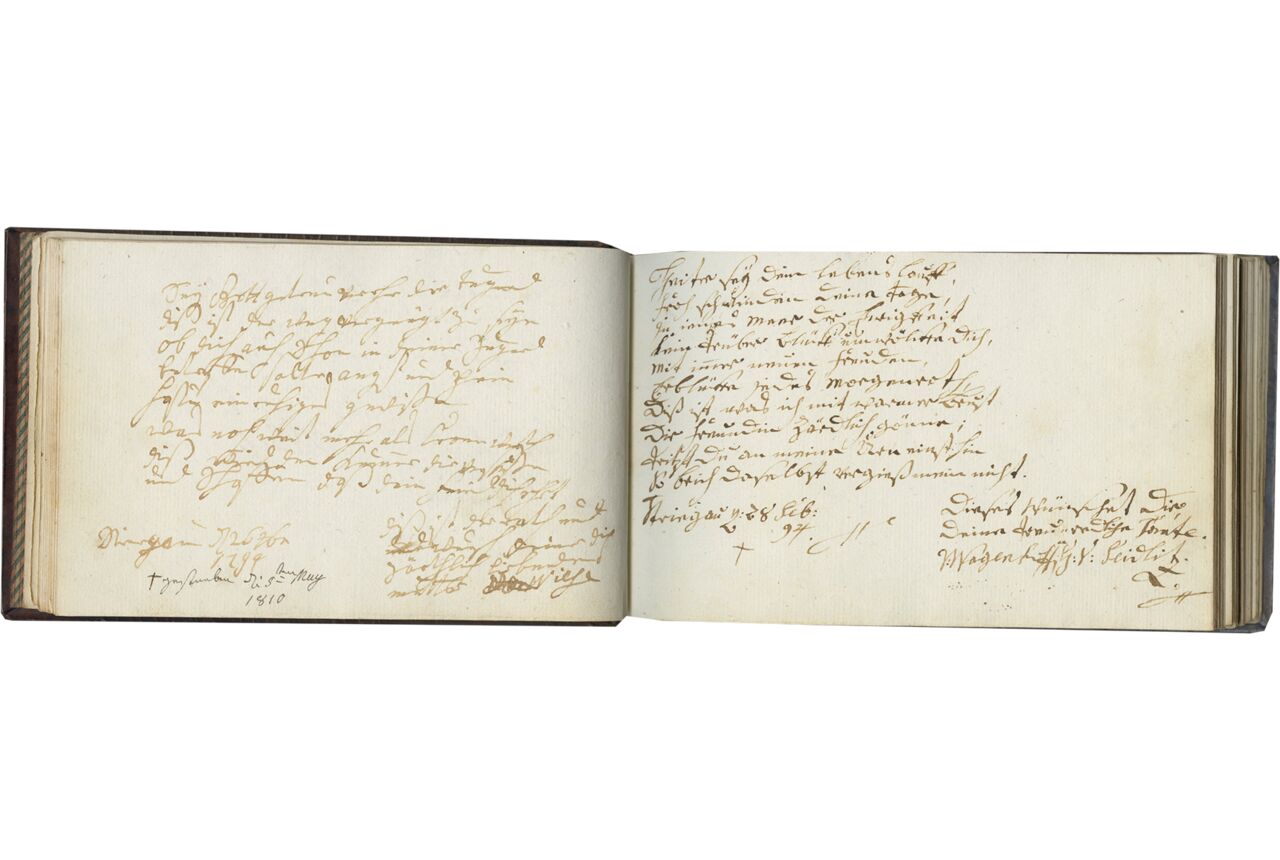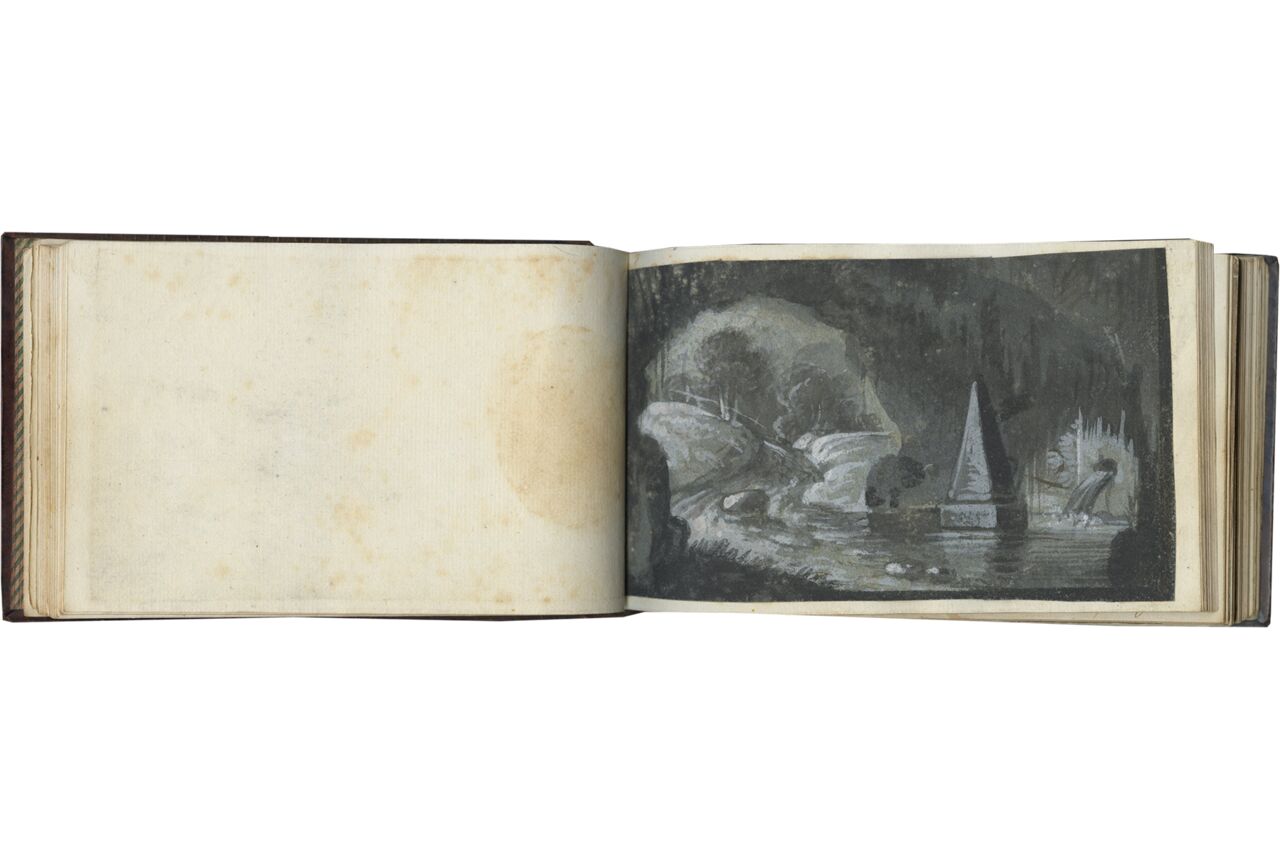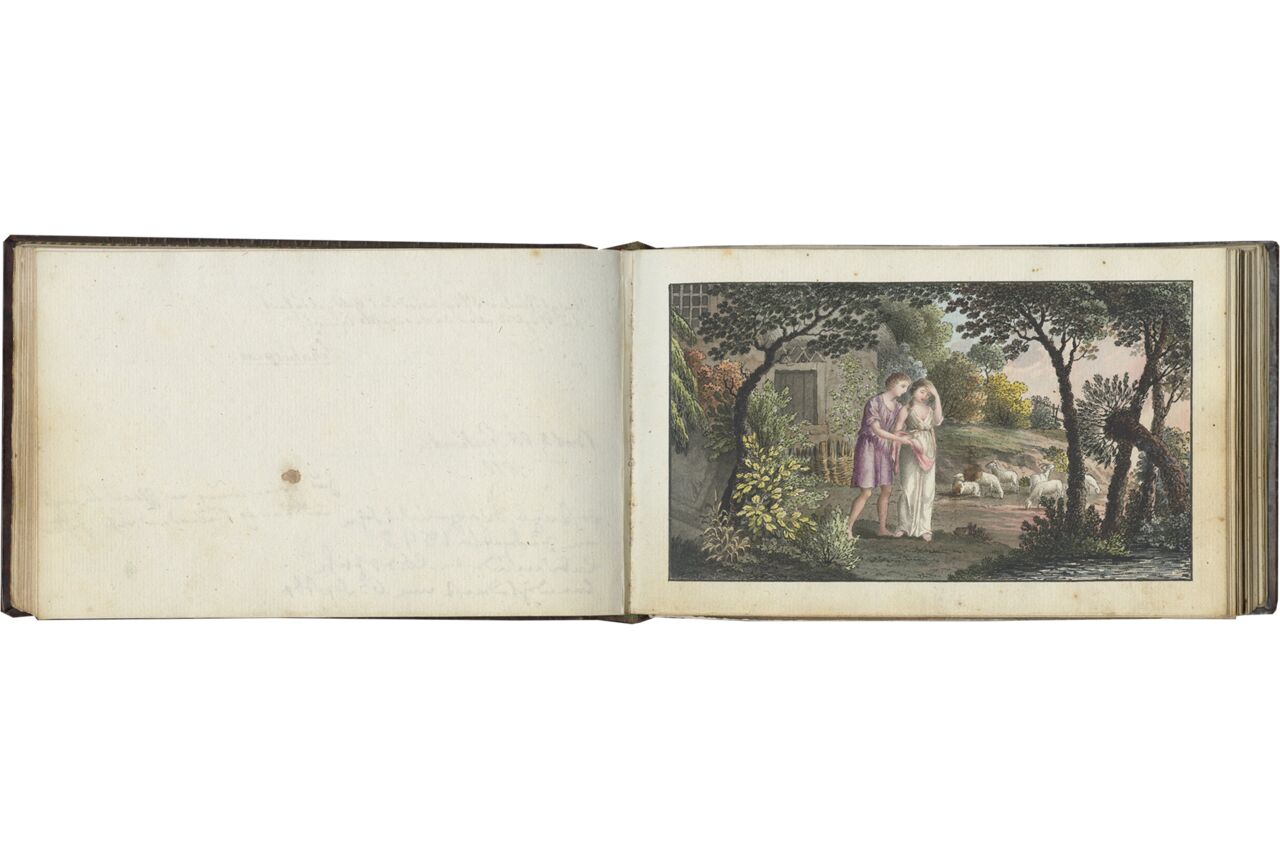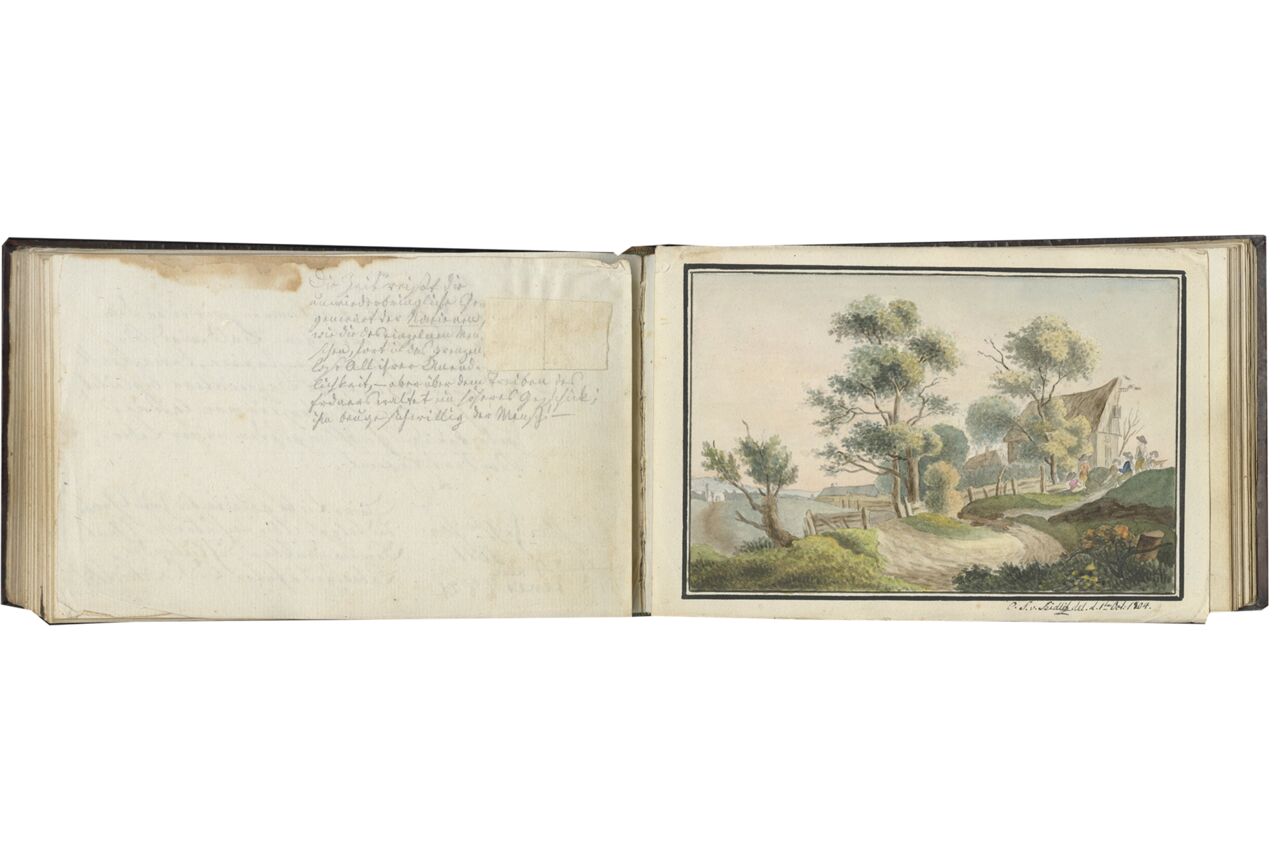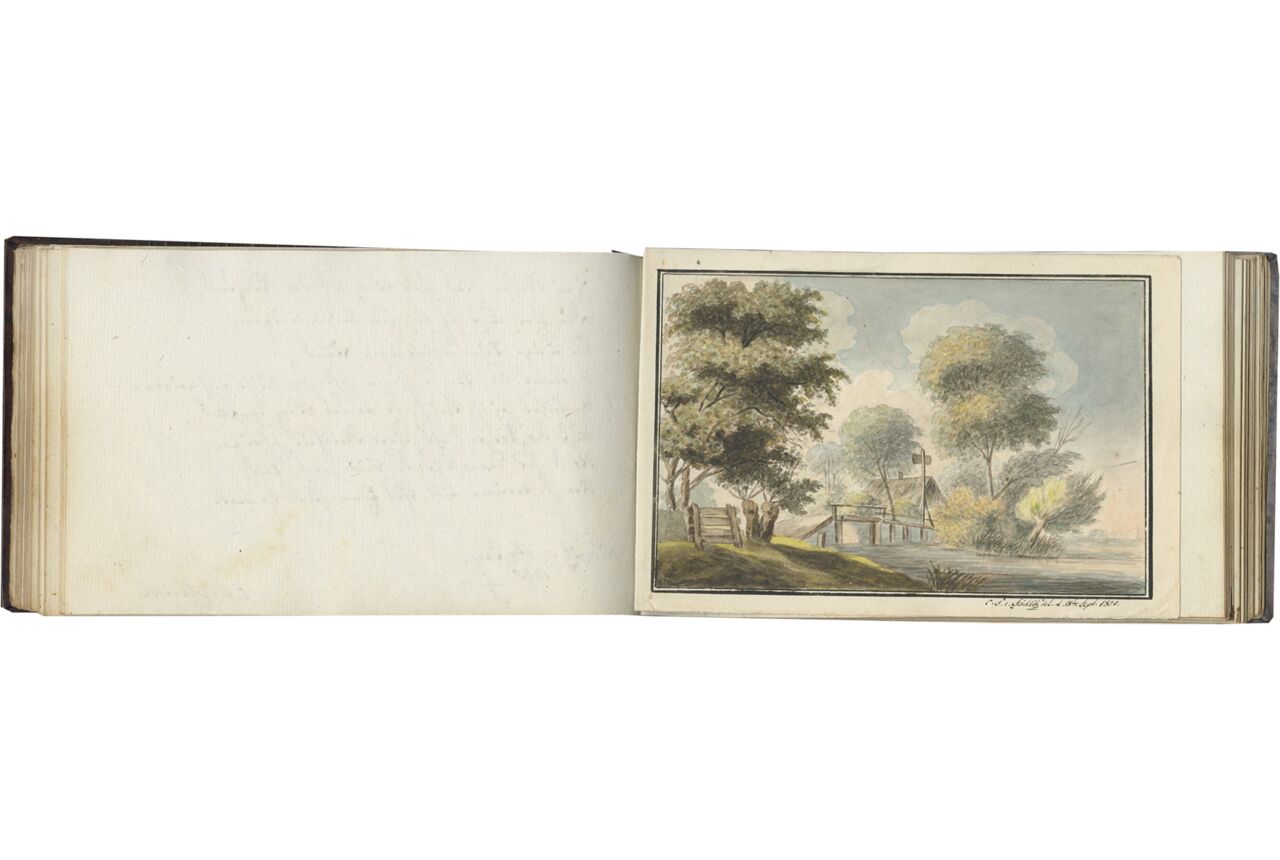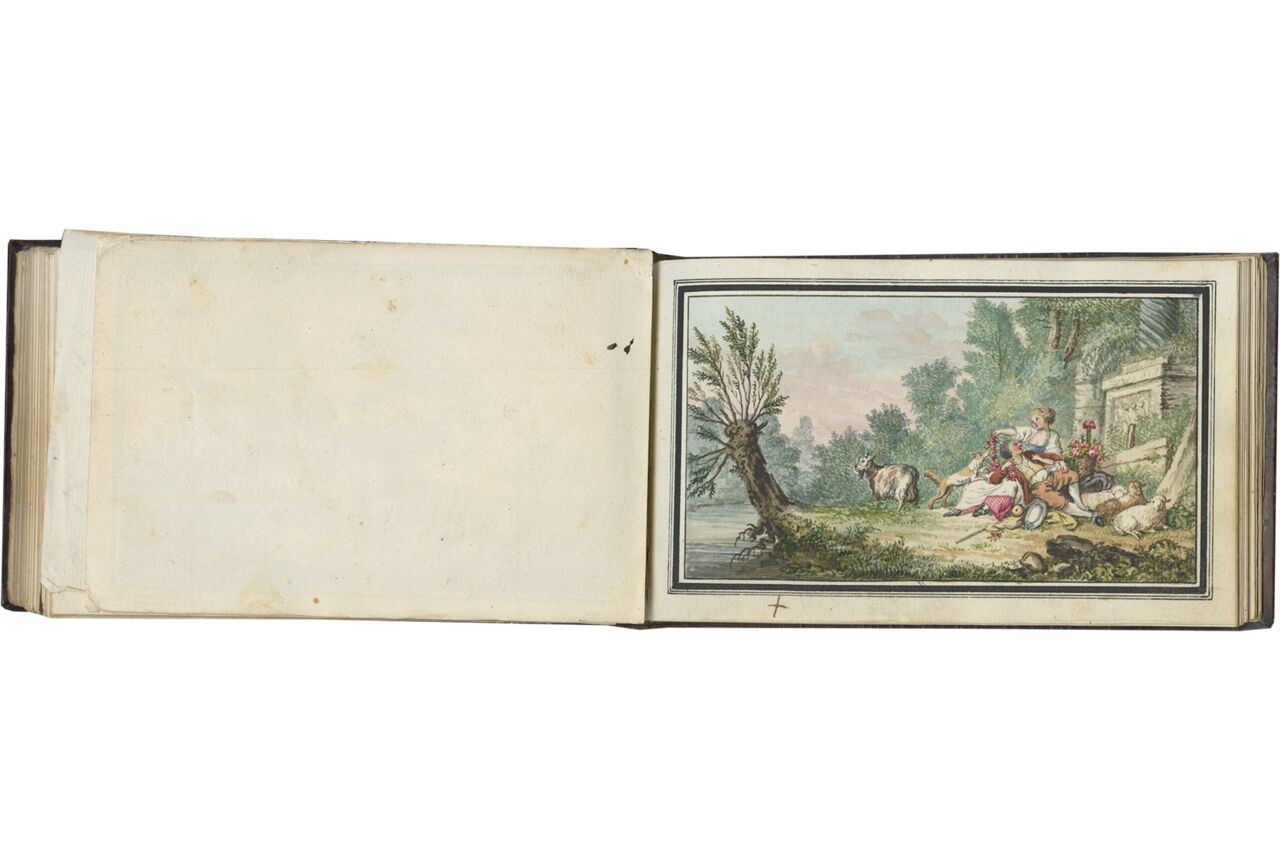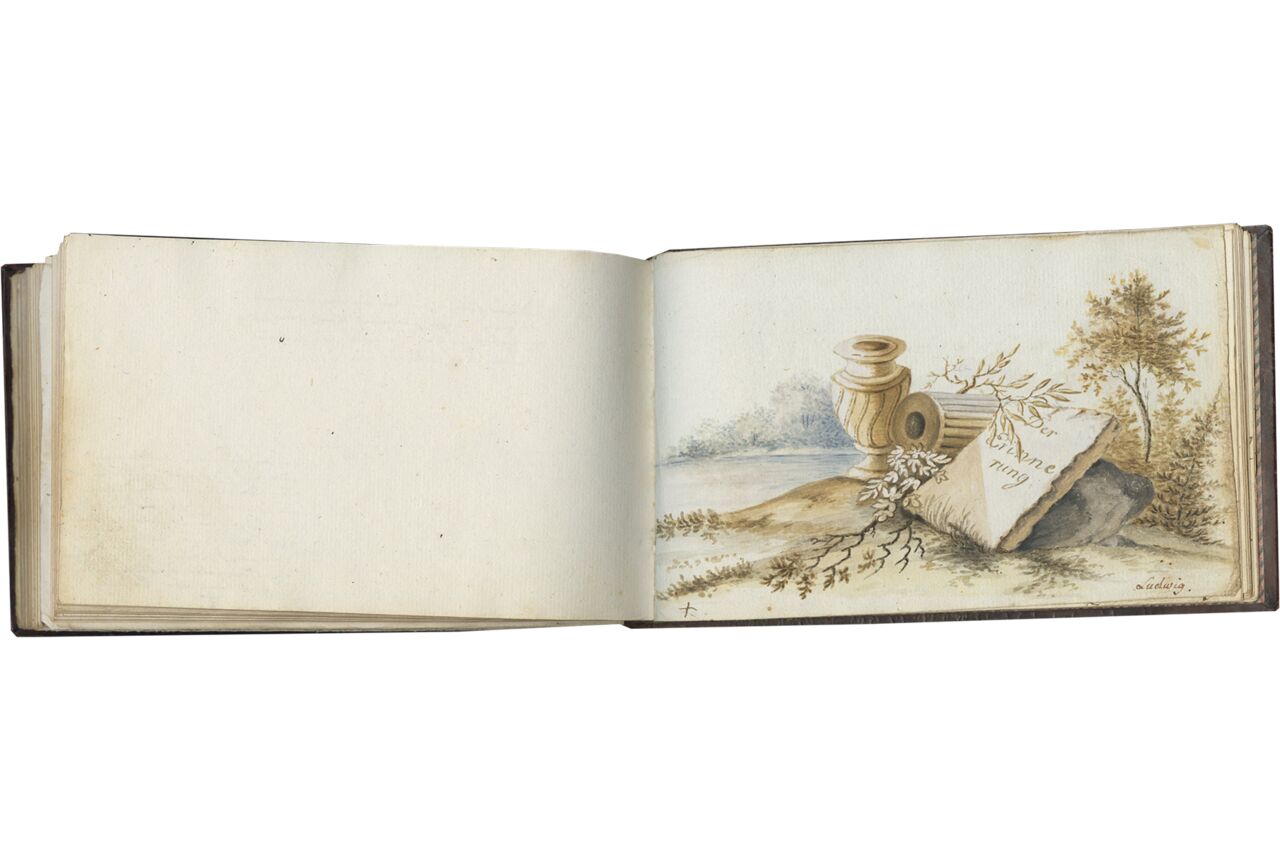132 folios on paper, watermark with a coat of arms (unidentified), modern foliation in pencil, 1-132, NINE WATERCOLORS, ONE GOUACHE PAINTING, ONE PEN AND INK DRAWING, ONE HAND-COLORED LITHOGRAPH, ONE COPPER ENGRAVING, some minor stains, ff. 49, 57, 88, 89 loose from the sewing, in overall excellent condition. ORIGINAL BINDING of mottled calf over pasteboards, covers gold tooled with a narrow foliage band forming a frame and small floral corner pieces, gilded initials on front cover “S.M.E.v.S.,” flat spine gold tooled with flowers and foliage bands, titled in gilt over a band of green leather “Dendmahle (denkmale) der Freundschaft,” gilt edges, patterned endpapers, leather somewhat rubbed on the covers and worn at the top of the spine, but in overall in good condition, kept within a contemporary slipcase of marbled paper, very worn. Dimensions 106 x 170 mm.
Less studied than the album amicorum typically made for men, those produced by women offer insightful glimpses into women’s social networking. Sophie’s album, collecting 85 souvenirs from friends and family of eminent German aristorcrats, displays especially fine illustrations, mainly watercolors of charming allegorical scenes and romantic pastoral landscapes, many undoubtedly inspired by local views in the Polish countryside, where the family lived.
Provenance
1. This is the album amicorum of Sophie Beate Maximiliane von Seydlitz, née von Wiese und Kayserswaldau (1772-1853). She was abbess of the Czerna (Tschirnau) convent in Silesia. Inserted in this volume is an engraving of the Pilgramshain manor house, built by the Seydlitz family in 1838 (see f. 3). The entries were made in different parts of Prussian Silesia (today southwestern Poland and eastern Germany), between 1794 and 1822, with one addition in 1845. The album is published in Jahrbuch der Auktionspreise für Bücher, Handschriften und Autographen 41 (1990), p. 924, and the “Repertorium Alborum Amicorum” (Online resources). The family had an important collection of engravings, including those by Dürer and Rembrandt (see Katalog der von den verstorbenen Herren Kammerherr Rudolph von Seydlitz und Heinrich Främbs..., Leipzig, 1912).
2. Collection of Konrad Schlossberger (1926-2022), a member of the Rhineland-Palatinate Chamber of Architects.
Text and Illustrations
f. 1, Pen and ink drawing enhanced in watercolor; it represents a landscape with a large white oval marble stele leaning against a tree; a kneeling female muse inscribes on the stone the following words: “Nur der Freundschaft Harmonie mildert die Beschwerden ohne diese Simpathie ist Kein Glück aus Erden. d. 25 May 1794” (Only harmony of friendship alleviates the complaints, without sympathy there is no happiness on earth);
f. 3, Poem, dated 20 March 1822, Wohlau (Wolow); with two loose prints (unnumbered): a hand-colored lithograph representing King George IV of England (r. 1820-1830), and a copper engraving showing the Pilgramshain manor house near Striegau, built in 1838 and owned by the Seydlitz family until 1884 (when it was given to Hans von Jeetze, whose mother was born von Seydlitz);
ff. 11-12, Poems by members of her family, signed von Wiese and von Seydlitz, dated 1794;
f. 19, Gouache painting pasted onto the page in gray tones representing a landscape with a river, a small waterfall and a pyramidal stone monument on the riverside;
ff. 22, 26, 37v-41, Ghort inscriptions and poems, a quote from Shakespeare;
f. 42, Pen and ink drawing painted in watercolors representing a shepherd and a shepherdess with sheep in a country landscape; the shepherdess brings her hand pensively to her forehead, while the shepherd gently supports her other arm;
ff. 43v, 44, 45, 46, 48, Poems entered by Charlotte von Hirsch and others;
f. 49, Watercolor of a church;
f. 51, Poem by the contemporary German poet, Friedrich von Schiller (1759-1805), entered by Caroline von Holtei in Breslau (Wroclaw) in 1811;
f. 52v, Watercolor of a small bouquet of forget-me-nots;
ff. 53, 54, 55, Poems entered by Friederike von Nickisch née Freiin von Richthoff;
f. 56, Poem entered by Eleonore von Rothkirch, dated 1796 in Liegnitz (Legnica, Poland);
f. 57, Watercolor representing a landscape with a bridge over a river and a country house surrounded by trees, signed C. S. von Seydlitz, 1804;
ff. 59-61, 62, 63, 64, 65, 66-69, 70, 71, 72, 73, 75, 76v, 78r-v, Poems entered by her cousin Wilhelmina von Seydlitz, as well as Eleonore von Rothkirch, Silvie and Louise von Elsner, Louise and Constance Zimmermann, Philippine von Sulskrang, Vivien von Rabenau, and others;
f. 79, Pen and ink drawing of a woman deep in revery resting by a pyramidal funeral monument; the scene includes a palm tree, two other tombs, a thorny bush, and forget-me-not flowers;
ff. 80, 81, 82-85, 86, 87, 88, pPoems entered by members of the Wiese and von Seydlitz families, von Bomsdorff, Julie von Rabenau née von Tschammer, and others;
f. 89, Watercolor representing a landscape with a country road that windsthrough a gate, below trees, leading to a farm house; a group of country people are gathered on a hillock near the house; signed C. S. von Seydlitz, 1804;
f. 90, Watercolor representing a romantic pastoral scene in a landscape: a man reclines on the lap of a a young woman who holds a garland of roses that falls over the man’s shoulder; surrounding them are three resting sheep, a goat and a sheepdog; a basket of roses is poised next to the couple; the scene takes place by a river or lake, next to the ruins of an ancient monument;
ff. 94r-v, 98, 99r-v, 103-105v, 108r-v, Poems entered by Sophia Hentschel, her cousin Friedrich von Rothkirch, Charlotte von Falkenhayn, Wilhelmina von Rothkirch, Auguste Zimmermann, and S. W. Schneidein; one poem in French entered by Beatrice Lefebre (f. 105v);
f. 111, Watercolor representing a landscape with a road cutting through fields, leading to a small cottage, spruce-fir forests and promontories; a church is perched on the highest bluff;
ff. 112-117, 118, Poems entered by Charlotte van der Velde, Schwarts, and others;
f. 119, Sepia painting in watercolor representing a still life with two antique vases, a slab of stone inscribed “Der Erinnerung” (Memory) and tree branches arranged on the bank of a lake, signed Ludwig;
ff. 120, 121, 122, 123r-v, 124v, 127-130, 131, Poems entered by Count Ludwig, Heuthausen, von Arnold, Charlotta Eleonora Stringen, Ernst Ludwig von Heuthhausen, and others;
f. 132, Inscribed 24 July 1813, otherwise blank.
Both the Seydlitz and the Wiese und Kaiserswaldau families are ancient noble Silesian families recorded since the thirteenth century. The latter was promoted to a Bohemian baronial rank in 1718. The Seydlitz family included several court officials, chamberlains, state elders, intellectuals and generals of the Prussian army, among whom Friedrich Wilhelm von Seydlitz (1721-1773), one of the greatest Prussian cavalry generals. The Seydlitz family seat was founded in Pilgramshain by Joachim Sigismund von Seidlitz und Ludwigsdorf in 1708. A new manor house for the family was built by Hans Rudolf Fedor Alexander von Seidlitz und Ludwigsdorf in 1838. Its classical style with clear lines is a rare exception to the neo-Gothic architecture of the time. The village was called Pilgramshain (“village of the stranger”) since 1318, and its eastern part Ludwigsdorf. A Protestant school was established in the village in 1758.
The album amicorum, or album of friends, is a booklet in which young aristocrats collected entries made by their friends and relatives. On the pages of the Stammbuch, as it was called in German, friends would usually offer poems, wishes, drawings and watercolors, signed with a date and current location. The album amicorum was popular from the sixteenth until the nineteenth century. It was initially favored by men in aristocratic, bourgeois and university circles, and entries were collected from acquaintances met during travels and studies. However, at the beginning of the nineteenth century, the albums were increasingly made for women. The decoration was adapted accordingly, and the entries were collected more locally, from among the closest family members and friends. These albums were more intimate, and no longer served as collections of remembrances of fellow students or prized inscriptions written by great scholars of one’s time. Throughout their history, the albums usually assumed an elongated horizontal format, as is the case for our manuscript.
The album amicorum is central to modern transdisciplinary research studying texts, reception and collecting in cultural and social contexts and the history of mentalities; see especially the comprehensive study by Werner Wilhelm Schnabel published in 2003. And album amicorum owned by women bring another important dimension to social history, as we listen to the voices of women who have often been forgotten or left aside in the past.
Literature
Fechner, J.-U., ed. Stammbücher als kulturhistorische Quellen, Wolfenbütteler Forschungen, 11,
Munich, 1981
Keil, R. and R. Die deutschen Stammbücher des sechzehnten bis neunzehnten Jahrhunderts. Ernst und Scherz, Weisheit und Schwank in Original-Mittheilungen zur deutschen Kultur-Geschichte, Berlin, 1893 (reprint Hildesheim, 1975).
Klose, W. “Stammbücher: eine kulturhistorische Betrachtung,” Bibliothek und Wissenschaft 16 (1982), pp. 41-67.
Kurras, L. Zu gutem Gedenken. Kulturhistorische Miniaturen aus Stammbüchern des Germanischen Nationalmuseums 1570-1770, Munich, 1987.
Lilienthal, M. Schediasma critico-literarium de philiothecis varioque earundum usu et abusu, vulgo von Stamm-Büchern, Königsberg, 1712; rev. Wittenberg, 1740 (repr. in Fechner, 1981, pp. 237-298). [the first study of Alba Amicorum].
Nickson, M.A.E. Early Autograph Albums in the British Museum, London, Trustees of the British Museum, 1970.
Rosenheim, M. The album amicorum, Oxford, 1910.
Schnabel, W. W. Das Stammbuch: Konstitution und Geschichte einer textsortenbezogenen Sammelform bis ins erste Drittel des 18. Jahrhunderts, Berlin, 2003.
Schünemann, H. “Stammbücher,” Schrifttumsberichte zur Genealogie und zu ihren Nachbargebieten 2 (1965), pp. 67-108.
Taegert, W. Edler Schatzholden Erinnerns: Bilder in Stammbüchern der Staatsbibliothek Bamberg aus vier Jahrhunderten, Bamberg, 1995.
Thomassen, K. (ed.). Alba amicorum. Vijf eeuwen vriendscap op papier gezet. Het album amicorum en het poëziealbum in de Nederlanden, Maarssen/The Hague, 1990.
Winkel, G. G. Biographisches Corpsalbum der Borussia zu Bonn 1821–1928, Aschaffenburg, 1928.
Online Resources
The Seydlitz family (Wikipedia):
https://fr.wikipedia.org/wiki/Famille_von_Seydlitz
Repertorium Alborum Amicorum:
https://raa.gf-franken.de/de/startseite.html
Our manuscript:
https://raa.gf-franken.de/de/suche-nach-stammbuechern.html?permaLink=1794_seydlitz
Suzanne Karr Schmidt, “Eighteenth-Century Social Networking,” October 20, 2021
https://www.newberry.org/18th-century-social-networking
TM 1276


